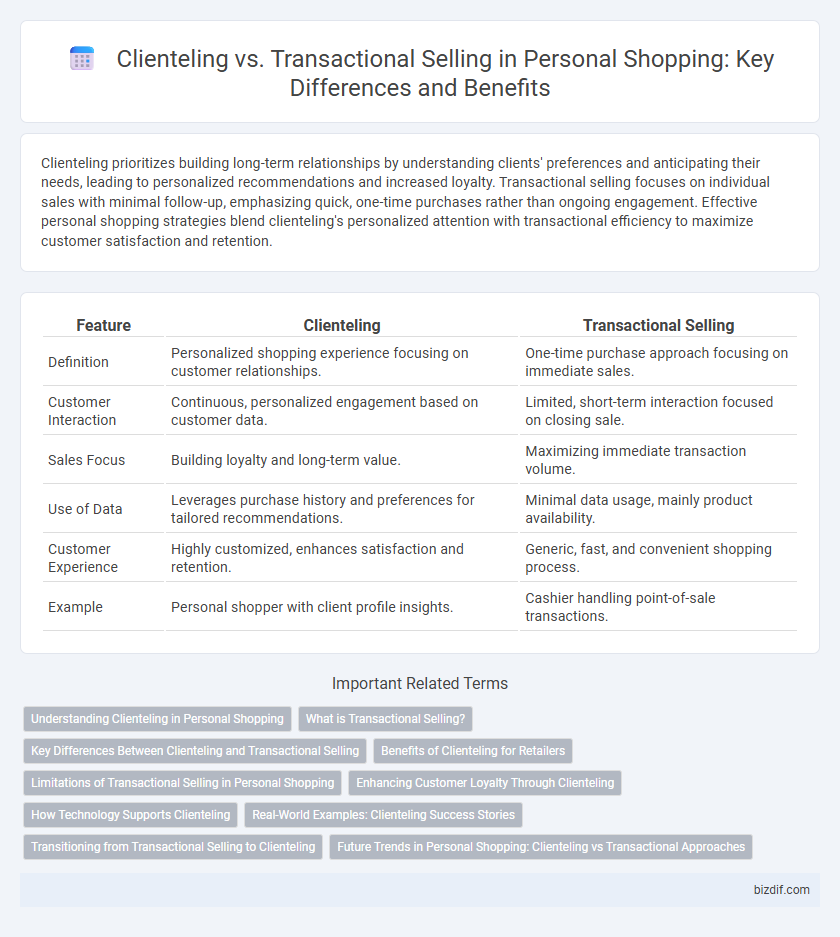Clienteling prioritizes building long-term relationships by understanding clients' preferences and anticipating their needs, leading to personalized recommendations and increased loyalty. Transactional selling focuses on individual sales with minimal follow-up, emphasizing quick, one-time purchases rather than ongoing engagement. Effective personal shopping strategies blend clienteling's personalized attention with transactional efficiency to maximize customer satisfaction and retention.
Table of Comparison
| Feature | Clienteling | Transactional Selling |
|---|---|---|
| Definition | Personalized shopping experience focusing on customer relationships. | One-time purchase approach focusing on immediate sales. |
| Customer Interaction | Continuous, personalized engagement based on customer data. | Limited, short-term interaction focused on closing sale. |
| Sales Focus | Building loyalty and long-term value. | Maximizing immediate transaction volume. |
| Use of Data | Leverages purchase history and preferences for tailored recommendations. | Minimal data usage, mainly product availability. |
| Customer Experience | Highly customized, enhances satisfaction and retention. | Generic, fast, and convenient shopping process. |
| Example | Personal shopper with client profile insights. | Cashier handling point-of-sale transactions. |
Understanding Clienteling in Personal Shopping
Clienteling in personal shopping emphasizes building long-term relationships by leveraging customer data, preferences, and purchase history to deliver tailored recommendations and personalized service. This approach enhances customer loyalty and increases lifetime value by anticipating needs and creating a seamless shopping experience. Unlike transactional selling, which focuses solely on individual sales, clienteling fosters ongoing engagement and trust between the shopper and retailer.
What is Transactional Selling?
Transactional selling focuses primarily on one-time sales, emphasizing quick exchanges rather than building long-term relationships. This approach prioritizes immediate product promotion, often neglecting personalized client needs and follow-up interactions. In contrast to clienteling, transactional selling lacks personalized engagement and repeat customer development strategies.
Key Differences Between Clienteling and Transactional Selling
Clienteling emphasizes building long-term relationships through personalized service, using customer data and preferences to tailor recommendations and experiences. Transactional selling focuses on single, one-time purchases with minimal interaction beyond the sale, prioritizing speed and volume over personalization. The key differences lie in client engagement depth, customer retention strategies, and the use of data analytics for personalized marketing.
Benefits of Clienteling for Retailers
Clienteling enhances retailer-client relationships by enabling personalized experiences based on detailed customer data, increasing loyalty and repeat purchases. This approach leverages CRM tools to track preferences, purchase history, and interactions, facilitating targeted marketing and tailored recommendations. Retailers benefit from higher customer lifetime value and improved retention compared to traditional transactional selling methods.
Limitations of Transactional Selling in Personal Shopping
Transactional selling in personal shopping often limits customer engagement by focusing solely on individual purchases rather than building long-term relationships. This approach overlooks personalized recommendations and tailored experiences that drive customer loyalty and repeat business. As a result, transaction-based interactions frequently fail to capture valuable client data, reducing opportunities for targeted marketing and customized service.
Enhancing Customer Loyalty Through Clienteling
Clienteling fosters deeper customer relationships by leveraging personalized data and purchase history to anticipate needs, resulting in tailored recommendations and exclusive experiences. This approach significantly enhances customer loyalty by creating emotional connections and demonstrating genuine care beyond a single transaction. In contrast, transactional selling focuses on individual sales without building ongoing engagement, often leading to lower retention rates and less repeat business.
How Technology Supports Clienteling
Technology enhances clienteling by leveraging customer data analytics and CRM systems to deliver personalized shopping experiences. Advanced tools like AI-driven recommendations and mobile clienteling apps enable sales associates to anticipate client needs and build long-term relationships. This personalized approach improves customer loyalty and increases repeat purchases compared to traditional transactional selling.
Real-World Examples: Clienteling Success Stories
Clienteling transforms personal shopping by creating lasting relationships, exemplified by luxury brands like Nordstrom, where sales associates use purchase history and preferences to deliver tailored recommendations, boosting customer loyalty and repeat sales. Transactional selling focuses on single purchases without personalized follow-up, missing opportunities for engagement seen in clienteling success stories from companies such as Saks Fifth Avenue, which increased customer lifetime value through proactive communication. Real-world examples highlight that clienteling outperforms transactional approaches by leveraging data-driven insights to enhance the shopping experience and drive higher revenue.
Transitioning from Transactional Selling to Clienteling
Transitioning from transactional selling to clienteling involves shifting from one-time sales focused on price and convenience to building long-term customer relationships based on personalized experiences and trust. Personal shoppers utilize data-driven insights and customer preferences to tailor recommendations, enhancing satisfaction and fostering loyalty. This approach increases repeat business and customer lifetime value by creating meaningful interactions rather than simple transactions.
Future Trends in Personal Shopping: Clienteling vs Transactional Approaches
Future trends in personal shopping emphasize clienteling, leveraging personalized data and AI-driven insights to build long-term customer relationships rather than focusing solely on transactional selling. Retailers increasingly integrate CRM systems and mobile apps to deliver tailored recommendations, enhancing customer loyalty and lifetime value. This shift prioritizes emotional engagement and personalized experiences over one-time purchases, reshaping the retail landscape.
Clienteling vs Transactional selling Infographic

 bizdif.com
bizdif.com